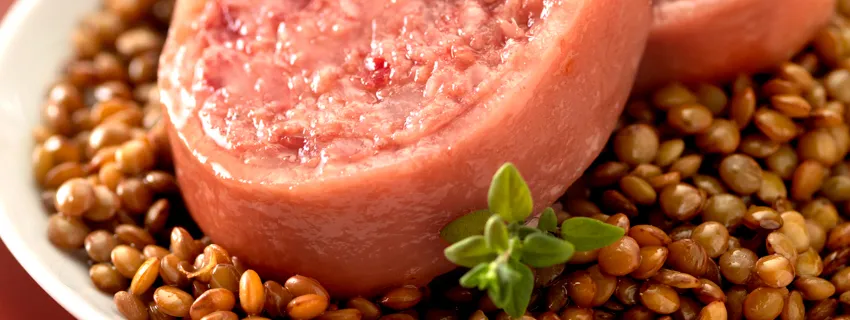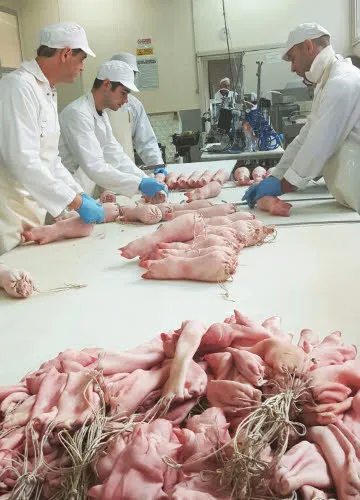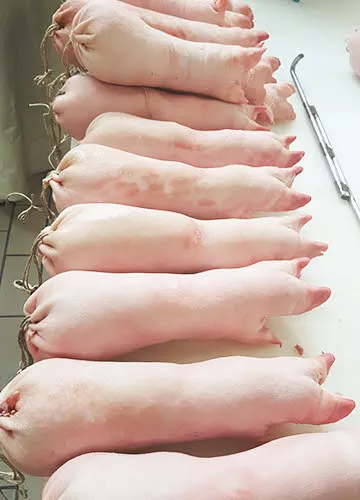Published:
Author: Antonio Maria Guerra
Zampone Modena
HISTORY, INFO, PLACES, INTERESTING FACTS

Zampone is undoubtedly one of the gastronomic excellences from the Italian city of Modena, heir to a very ancient rural tradition that contributes to increase its charm. Let’s find out its history, its preparation and a large number of interesting curiosities, with the precious help of its most traditional producers, united in the Consorzio Zampone e Cotechino Modena IGP.

What is ‘Zampone’?
Zampone is a typical sausage from Modena (* 1), an ancient town located in the Italian region of Emilia-Romagna. It consists of a mixture of pork meat (*2) and rind, stuffed in the front leg of the animal (*3). What distinguishes Zampone from its closest relative, the ‘Cotechino’, is that the mixture of the latter (*4) is stuffed in the intestine skin. The specialty was born, roughly, in the ‘500. Over the centuries, it experienced a growing success until, in 1999, gained official recognition with the assignment of the Protected Geographical Indication (PGI) by the European Community.
Notes:
*1: Tradition has it that Zampone was invented in Mirandola, a village in the province of Modena;
*2: Lean meat, from the musculature, and fat, from the adipose tissue of the pig;
*3: Leg deboned and emptied;
*4: Generally almost identical to that of Zampone;

Zampone Modena
THE MOST TRADITIONAL PRODUCERS
This article is the result of collaboration between WebFoodCulture and the Consorzio Zampone e Cotechino Modena IGP: organization gathering the most traditional producers of the famous specialty.


The history of Zampone Modena.
As often happens when dealing with the origins of Italian gastronomic specialties, also in the case of Zampone it’s possible to come across a fascinating story, connected to a distant past. Its birth is traced back to the winter between 1510 and 1511, during the siege lead by a warrior pope, Giulio II della Rovere, to the citadel of Mirandola (*1).ì Legend has it that the cooks of the fortress, realizing the imminent defeat, to prevent the pigs from falling into the hands of the Papalines (*2), decided to stuff their meat inside the deboned legs.
Read more
This is how the famous Emilian sausage may have originated (*3): the conditional is required, since it’s legitimate to suspect that, at least in part, the story could be just a legend. Anyway, it’s important to take it into account, as it indicates the period in which Zampone began to be produced, that is to say, the sixteenth century, right in the middle of the Renaissance.
Notes:
*1: Municipality in the Province of Modena;
*2: If this story were true, it’s possible, if not probable, that the soldiers of Giulio II were among the first to appreciate the taste of Zampone!
*3: According to another version of the story, perhaps more plausible, Zampone was invented by the cooks of Mirandola to preserve pork, giving way to withstand the long siege;
Modena, the city of Zampone.
Modena and its province are widely considered the home of Zampone. This is not surprising, considering the centennial tradition that this area can boast in the production of cured meats.
Read more
The city is located in the heart of Emilia, one of the most interesting Italian regions from a culinary point of view. Its ancient history dates back to Roman times and is evidenced by many monuments declared World Heritage Sites by UNESCO.

How Zampone is made?
Here follow the steps of the preparation of Zampone Modena PGI (*1):
1) The procedure starts with the mincing in a meat grinder of the muscle and adipose tissues of the pig, as well as the rind (*2);
2) Continues with the kneading (*3) of the minced meat. Salt and pepper are added;
3) It’s finally time to stuff the mixture into the skin of the pig’s foreleg, including the distal phalanges (*4);
Zampone Modena PGI is sold fresh (after drying) or cooked.
Notes:
*1: Information included in the Product Specification document of Zampone Modena PGI;
*2: Molds with holes of different diameters are used: 7/10 mm for the muscle and adipose tissues, 3/5 mm for the rind;
*3: The kneading takes place in special vacuum machines;
*4: The upper part of the leg, once it has been filled, is closed with a strap.

The production areas.
To identify with precision the areas in which Zampone Modena PGI is made, it’s sufficient to consult its Product Specification, a document that certifies and protects the characteristics of the product.
Read more
The birthplaces of the specialty are the Italian provinces of: Modena, Ferrara, Ravenna, Rimini, Forlì-Cesena, Bologna, Reggio Emilia, Parma, Piacenza, Cremona, Lodi, Pavia, Milan, MonzaBrianza, Varese, Como, Lecco , Bergamo, Brescia, Mantua, Verona and Rovigo.

Calories and nutritional values.
One hundred grams of Zampone Modena contain approximately 350 kcals.
Read more
The specialty includes proteins, fats, carbohydrates and sodium. Among the minerals: phosphorus, iron and calcium.

Zampone and Cotechino: the differences.
Zampone is often considered a very close relative of another sausage: ‘Cotechino’. This drives us to compare the two specialties to find out what they really have in common and the main differences between the two.
- Birthplace: although the province of Modena is generally considered the birthplace of both the specialties, some scholars claim that, in truth, Cotechino could be originally from the Italian region of Friuli-Venezia Giulia;
- Appearance: the two sausages have a very different appearance. While the meat of Zampone is stuffed in the front leg of the pig (properly emptied and deboned), that of Cotechino is stuffed in its intestine skin;
- Meat mixture: the fillings of the two specialties are very similar to each other, made mostly with pork meat (lean and fat), rind, salt and pepper;

Zampone: pairings.
Zampone lends itself to many tasty pairings. The most classic is undoubtedly the one with lentils, usually served on New Year’s Eve as a good luck dish.
Read more
This is not surprising: pig has always been considered a symbol of abundance, while lentils bring wealth. Among the other side dishes, we can mention mashed potatoes, stewed beans and cooked vegetables.


The origins of the name.
‘Zampone’, the famous Modenese sausage, takes its name from the casing in which its meat is stuffed: the front leg (in Italian ‘zampa’) of the pig properly deboned. It is said that until the nineteenth century, the specialty was known as ‘Zampetto’ (small leg)
Read more
The reason for the change should be the increase in the average size of the pigs (and therefore of their legs), which took place over time.

Zampone and literature.
There is no lack of references to Zampone in literature, as proved by the writings of the Bolognese agronomist Vincenzo Tanara, author of the treatise ‘L’economia del cittadino in villa’, and by those of Vincenzo Agnoletti, a Roman cook in the service of Maria Luigia, Grand Duchess of Parma.
Read more
In this regard, it’s impossible not to mention a phrase of the famous writer Émile Zola who, with reference to the specialty, said “if you want joy, eat Modenese food, the Zampone gives joy to a sad soul”.

The right wine for Zampone.
There are no doubts about the right wine to pair with a tasty Cotechino: the best choice is a dry Lambrusco di Sorbara. Its acidity (freshness) and effervescence are ideal to balance the fatness and greasiness of the specialty.

‘SuperZampone’, the Guinness Zampone.
For more than 30 years a very interesting event (*1) has been organized in the small Italian town of Castelnuovo Rangone (in the province of Modena), an event during which Zampone is celebrated. It’s not surprising, considering that pigs has always been at the very center of the economic life of this area (*2).
Read more
On this occasion a huge ‘SuperZampone’ is made by the local Master Salumieri: suffice it to say that the one prepared in 2014 was so big (1038 kg) that rightfully entered the Guinness Book of World Records. The event, in addition to a large number of people, has always attracted many celebrities, including the tenor Luciano Pavarotti and the conductor Claudio Abbado.
The Association that has linked itself to the specialty has an official website (LINK).
Notes:
*1: The event is promoted by the Municipality of Castelnuovo Rangone, not by the Consortium Zampone and Cotechino Modena PGI.
*2: It’s no coincidence that a bronze monument in the shape of a small pig is right at the center of the main square of Castelnuovo.

The PGI and the Product Specification document.
In 1999 the European Union assigned the Protected Geographical Indication (PGI) to Zampone Modena, thus recognizing the main characteristics of the specialty, its strict connection with a specific production area and, ultimately, its unique value.
Read more
All the information to identify the original product, including, among other things, its ingredients and the particular method of preparation, can be found in the Product Specification document that can be consulted on the official page of the Consortium Zampone and Cotechino Modena PGI.

Consorzio Zampone e Cotechino Modena PGI: contacts.
Address: c/o Assica – strada pal. Q8 20089, Rozzano (MI) – ITALY
Official website: www.modenaigp.it
Mail: info@modenaigp.it
Tel.: +39 02 8925901
FAX: +39 02 57510607
Copyright information.
The images displayed in this page belong to WebFoodCulture and to Consorzio Zampone e Cotechino Modena PGI, with the exception of:
Public Domain images
- PGI Logo (Wikipedia Link);




